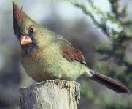 Northern Cardinals
Northern Cardinals
Identification and Pictures
Male Northern cardinals (Cardinalis cardinalis)
are all red with the exception of the black patch around
their thick triangular or conical bill. Their
bright color, and the pointed crest make them instantly
identifiable by bird enthusiasts. They keep this
bright red plumage year round, and it is very striking
in snow.
photo by Hollingsworth us
Wildlife
|
 |
| The female is brownish with some red on the wings, and
tail. Just like the male, the female has a dark
face, and heavy red bill, good
for eating seeds. Adults are 7 ½ to 9 inches.
Young birds look much like the female, with darker
bills. |

by Menke, Dave US Wildlife |
At one time cardinals were kept as caged pets,
but the Migratory Bird Treaty Act of 1918 banned the practice
in the U.S.
Sound
Cardinals have several variations of repeated whistles (whe-cheer-cheer
or whertee-whertee-wherte). A contact or alarm call
sounds like chip. Female cardinals sing while they are
on their nest. A pair will have song phrases they share.
Cardinal song Click
to hear Sound
Range and Habitat
The Northern cardinal is a year round resident
of the eastern U.S., and continues to spread north. It
is so well liked that more states have adopted it as their state
bird than any other bird. These states are: Illinois,
Indiana, Kentucky, North Carolina, Ohio, Virginia, and West
Virginia.
They like the edges of wooded areas, river
thickets, and gardens. You can find them in areas near
people such as parks, and backyards.
Nesting and Breeding
Breeding season begins in late March to early
April. Cardinals will breed in a wide variety of areas.
Once he develops a territory the male
cardinals will aggressively defend it. They have been
known to attack their reflections in windows, mistaking them
for other males.
The male feeds the female during courtship. Cardinals
will mate for life, and remain together throughout the entire
year.
The male usually follows the female as she
searches for a nest site. They carry nesting material in
their beaks, as they call back and forth to each other.
They prefer to build their nest in shrubbery or a thickly
branched tree. Males may bring nesting material to the
female, who will build a cup shaped nest in 3 to 9 days. Nesting materials are twigs, weeds, and grasses, bark fibers,
dead leaves, moss, rags, and other debris.
Nesting materials are twigs, weeds, and grasses, bark fibers,
dead leaves, moss, rags, and other debris.

The female will lay between two, and five
white or greenish eggs with dark streaks, and spots on them.
Usually the female will incubate the eggs for 11 to 13 days.
The young will be fed by both parents for around 10 days, and
will be able to fly well in about 20 days.
Two, three, or four broods may be raised in a breeding season.
The male will tend the brood while the female starts the next
brood.
Feeders and Food
Natural foods
In the wild, Cardinals eat fruit, seed, and insects.
Their heavy conical bills
allow them to eat a wider range of seeds than birds with
smaller bills such as sparrows or finches.
They search from the ground for food and can
be heard foraging in bushes when they are out of sight.
As they hop around they will scratch the ground with both feet
searching for insects and other food.
Attracting Cardinals to your
Backyard

Because Cardinals are not migratory you can attract them to
your yard all year long with feeders, water, and shrubs.
Many kinds of shrubs and trees will attract them to your yard.
Some are, blueberry, cherry, dogwood, mulberry sumac.
In addition to eating any fruit these may provide, they may
nest and raise their young in the dense shrubs.
Feeders
If you put out feeders they will eat almost any kind of fruit,
and seeds you offer them. Good food choices are cracked
corn, millet, bread, nutmeats, safflower, peanut butter mixes,
and suet. A favorite is un-hulled black-oil sunflower
seeds.
If you watch them at the feeder you will see them touch beaks
as they offer each other seeds.
Water
In addition to food; provide a source of water for drinking
and bathing. Many birds will come to clean their
feathers in a birdbath. Running or dripping water will
also attract them. Birds love to bathe in a slow
sprinkler.
For more on food
and feeding click here.
For more on feeders click here.
To learn about other favorite
birds click here.

|
